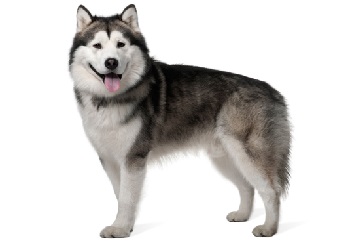 The Alaskan Malamute evolved from early Spitz-type dogs living in the Arctic regions. The breed was perfect as a sled dog for the Mahlemiut Inuit Eskimos, taking these nomadic people and their possessions from campsite to campsite. It could endure the cold and harsh conditions and is still valued for its strength and stamina.
The Alaskan Malamute evolved from early Spitz-type dogs living in the Arctic regions. The breed was perfect as a sled dog for the Mahlemiut Inuit Eskimos, taking these nomadic people and their possessions from campsite to campsite. It could endure the cold and harsh conditions and is still valued for its strength and stamina.
The Malamute was used by troops in World War II as a search and rescue dog and as a sled dog by explorers on research expeditions to Antarctica. It is bred for its power and endurance.
Today, Alaskan Malamutes are still used as sled dogs for personal travel, hauling freight or recreational activities, such as sledding (also known as mushing). But most are family pets, performing in the show ring or various canine sports.
Personality
The Alaskan Malamute is a pack animal. It is strong, dominant and intelligent, and loves outdoor activities. Its intelligence and need for stimulation means it is easily bored and may become destructive if not exercised and socialized properly.
Malamutes are easy going, placid and fun loving dogs. They are also friendly and gentle with people, but they can also be stubborn and independent, ignoring their family with disregard and happily following a stranger. The trick is to teach Malamutes to respect their owners by making them feel your attention is something to be valued and earned. A Malamute that does not learn respect as a youngster is extremely difficult to change as an adult.
As they are very intelligent and independent-minded, they can be challenging to train. The Malamute generally does not tolerate strange animals that encroach upon its territory or dogs of the same sex. They are usually quiet except when excited, but if they are bored they may howl and ‘talk’ loudly. Malamutes are friendly and rarely bark so they cannot be relied upon as a watchdog.
Upkeep
Obedience training is essential for Alaskan Malamutes and should start as early as possible. As for exercise, they need a reasonable amount such as a long daily walk.
This dog is not suited to extremely hot humid climates and needs plenty of shade and water. However, it has a double coat which provides insulation against both heat and cold and, thus, should not be shaved in summer. The undercoat is shed in copious, large clumps once or twice a year and during this time will need daily brushing, but otherwise require minimal coat maintenance and infrequent washing.
Like all dogs, Alaskan Malamutes require regular tick, flea, intestinal worms and heartworm treatments. Consult your veterinarian on treatment options. Desexing and vaccination against diseases, such as the deadly parvo virus and highly infectious canine cough, are also important to discuss with your vet.
Compatibility
The Malamute needs a strong role model and a good leader – one who can lead this willful dog with confidence. The Malamute does not respond to harsh treatment so it needs a humane approach to training to build its confidence in its owner as the pack leader.
Alaskan Malamutes have a high rate of abandonment, probably due to their strength, unfriendliness towards other animals and destructiveness when bored. They are also good escape artists when looking for something to do. A commitment to training and incorporating a Malamute into your family and lifestyle is essential for success with this breed.
The Malamute also has a strong prey drive and while some will tolerate other smaller pets, it is necessary to supervise a Malamute around small children and animals and they can never be walked off lead. Malamutes cannot be kept indoors or in an apartment and should have a large yard.
Fact file
Breed classification Working dog
Size Large
Origin The Arctic
Lifespan 10-12 years
Colors White, grey-white, black-white and red-white
Cost $1000-$1700
Common hereditary problems Hip dysplasia, cataracts, epilepsy and hypothyroidism
